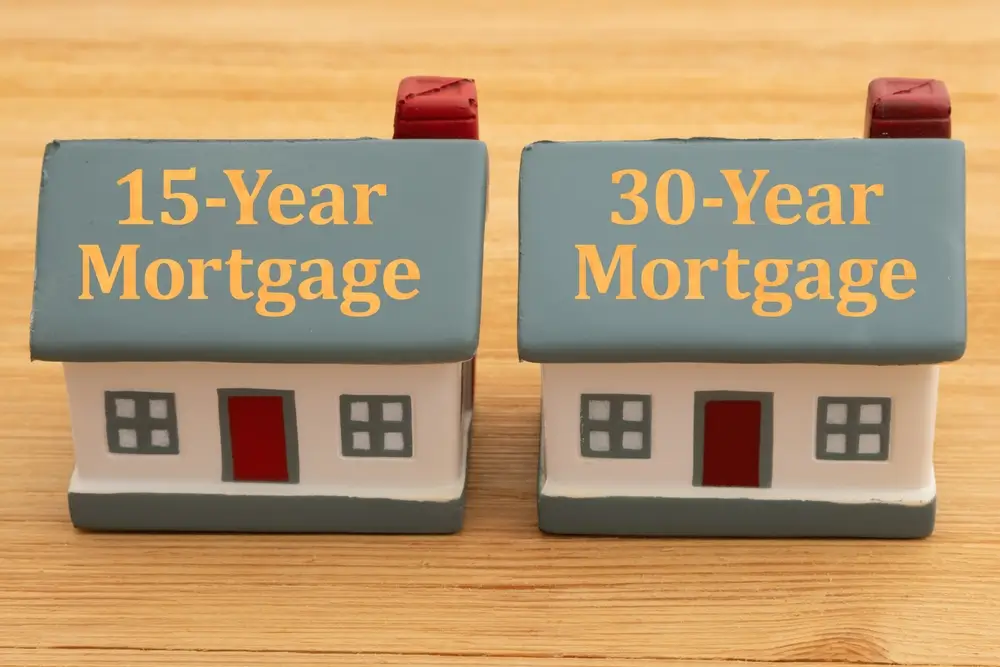Your household budget’s most oversized line item will likely be your monthly mortgage payment. The type of mortgage you select, especially whether it’s a 15-year or 30-year mortgage, will affect the amount of your monthly payments. While a 30-year plan reduces your monthly payments but eventually costs more in interest, a shorter schedule necessitates larger payments but enables you to pay off the loan more quickly.
Here’s how to determine if a 30-year or 15-year mortgage is better for you.
An Overview of 15-Year vs. 30-Year Mortgage
Mortgages with terms of 15 and 30 years are structurally similar; the term is the primary distinction. A 15-year mortgage typically has lower long-term costs, but a 30-year mortgage may make your monthly payments more manageable.
The majority of homebuyers choose a 30-year fixed-rate mortgage, which is essentially the quintessential financial instrument.
However, a 15 year fixed-rate mortgage might have been a better option for many buyers. Even though the monthly payments might be higher, they could save thousands of dollars in interest.
What is The Difference Between 15-year VS. 30-year Mortgages?
Mortgages with terms of 15 and 30 years both come under fixed-rate loans. The primary distinction is their terms, or how long you must repay them.
Because it enables the borrower to extend loan payments over three decades, the 30-year, fixed-rate mortgage is the most common choice for most Americans purchasing a home. By doing this, the monthly payment remains easier to manage. However, it does result in a higher overall interest payment for the loan.
Borrowers pay off their loan in ten and a half years with a 15-year mortgage. Each monthly loan payment will, therefore, be higher. However, because you will be paying interest for a shorter time, the total cost of the loan will be lower.
“When all else is equal, the longer the term, the lower the payment amount. This is because the mortgage amount is amortized over a longer period.” Additionally, the annual percentage rate, or APR, of a 15-year mortgage will be lower than a 30-year mortgage. Lenders offer lower rates on shorter loans because estimating repayment over 15 years is more straightforward than a 30-year one.
Your monthly payments for a 30-year mortgage are typically less than those for a 15-year mortgage, even if the rate is lower. There are so many options to have a 30 or 15-year mortgage. You must explore this: VA IRRRL: How to Refinance Your VA Loan with Ease (Internal linking)
Benefits of a 15-Year Mortgage
Below are the benefits of a 15-year mortgage over a 30-year mortgage. Both have fixed rates and payments over their terms.
- Lower Total Interest
Since the total interest payments for a 15-year mortgage are lower than a 30-year mortgage, the 15-year mortgage ultimately costs less. As you’re borrowing the money for half as long, the total interest paid will be half of what you will spend over 30 years. An annual interest rate sets the cost of a mortgage. You can use a mortgage calculator to see how interest rates affect your monthly payment. Using this, you can also determine how a 15-year mortgage differs from a 30-year mortgage.
- Reduced Fees
You will pay less in fees for a 15-year loan if one of the government-sponsored agencies buys your mortgage. These government-backed companies impose what they refer to as loan-level price adjustments, which are typically higher for 30-year mortgages or only apply to 30-year mortgages.
Borrowers who make smaller down payments and have lower credit scores are usually subject to these fees. For borrowers who are 15 years old, the Federal Housing Administration (FHA) offers reduced mortgage insurance rates. Lenders require private mortgage insurance or PMI when your down payment is less than 20% of the home’s value.
- Lower Interest Rate
A 15-year mortgage usually has a lower interest rate. This is because short-term loans are less risky and less expensive for banks to fund than long-term loans. The difference between the rate and the 30-year mortgage can range from a quarter-point to a whole point.
- Forced Savings
Financial planners view a 15-year mortgage as a form of forced savings because of the higher monthly payment. In other words, you would invest the money you save each month from a 30-year mortgage in your home. It will likely increase in value over time rather than in a money market account or the stock market.
Benefits of a 30-Year Fixed Mortgage
A 30-year mortgage is more manageable to qualify for and may allow you more flexibility in your monthly budget. Explore the benefits of this:
- Low Monthly Payments
A 30-year fixed-rate mortgage has the lowest monthly payment of all conventional fixed-rate loans, assuming the principal balances are the same.
- Payment Flexibility
The reduced payment will give you more options if you encounter financial difficulties, like prolonged illness or a layoff. Alternatively, you can make more oversized or additional payments. It is effective if your household income increases. Ultimately, it will shorten the mortgage’s term and lower the total interest you pay. By increasing the monthly payments by a few hundred dollars, you can convert a 30-year mortgage into a 15-year mortgage.
- More Home
A 30-year fixed-rate loan enables you to pursue a more costly home. The system evaluates applicants based on their ability to make payments.
- Possible Tax Deduction For Mortgage Interest
Under current tax laws, the 30-year fixed-rate mortgage has the highest interest payments. Also, homeowners can still deduct mortgage interest from their taxable income. But there is a catch to the arrangement. Once a critical incentive for listing filers, the mortgage-interest deduction lost much of its appeal when tax reform passed in 2017. It included significant increases in the standard deduction as part of a simplification effort. Ask a tax professional if itemizing will be beneficial for your deduction.
- Monthly Predictable Payments
A smaller monthly predictable payment also allows you to save for other priorities. These penalties include vacation planning, education, retirement savings, and home maintenance when times are good.
- 30-year Lock-In of Low Rates
If you are lucky enough to receive a lower mortgage rate, it will remain fixed for the duration of the loan. However, variable interest rates may fluctuate depending on the state of the economy.
Are You Better Off With a 30-Year Or 15-Year Mortgage?
Because 15-year mortgages have higher monthly payments, they have more robust financials. Lenders look for a higher salary and a lower debt-to-income ratio.
However, you are eligible for both loans. Your choice should ultimately be based on how much you can afford to pay for your mortgage and whether a higher payment would put you in a difficult financial position and prevent you from taking other crucial financial actions, such as retirement.
Here are some important considerations to make when deciding between the two:
- Check Your Monthly Budget Carefully
Analyzing your spending plan and financial obligations can help you determine the type of mortgage payment that will be practical for you. Consider taking out a 30-year loan and making additional payments to pay it off sooner. This option becomes beneficial if you feel constantly overburdened by the payments on a 15-year mortgage.
- Understand Your Earnings And Commitments
According to former National Association of Mortgage Brokers president Rocke Andrews, “The consumer also needs to consider the reliability of their income and debt levels.” Additionally, remember that people with commission-based or seasonal income may find the requirements for a 15-year mortgage difficult.
- Determine Mortgage Payments on a Range of Price Points For Homes
We recommend sticking to the 28 percent and 36 percent rules. These regulations advise purchasers that monthly mortgage payments should not exceed 28 percent of their gross income and that monthly debt payments should not exceed 36 percent of their gross monthly income.
The Impact of Mortgage Terms on Cost
A mortgage is a specific kind of term loan backed by real estate. The borrower makes annual interest payments against the loan’s remaining balance. The monthly payment and interest rate are both set.
Because of the fixed monthly payment, the amount that goes toward principal and interest changes over time. Due to the significant loan balance, most of the initial payment is interest. Howevpayment’s interest portion payment decreases, and the principal portion rises as the balance decreases.
Summarize
Do your homework before choosing between a 30-year and a 15-year mortgage because it will affect your finances for decades. A 15-year loan might be a better option if your goal is to repay the mortgage sooner. Also, you can afford larger monthly payments with this option.
On the other hand, a 30-year loan’s lower monthly payment might enable you to purchase a larger home. This second option allows you to free up money for other financial objects.
A mortgage calculator can help you better understand how much house you can afford based on your income. It estimates monthly payments for a 30-year versus a 15-year mortgage.
FAQ’s
Should I make additional payments on a 30-year mortgage or get a 15-year mortgage?
You can accelerate the payoff of a 30-year mortgage without restricting yourself to 15 years. This can be done by applying additional payments to your principal. Since 30-year loans frequently have higher interest rates, do the maths to determine if the flexibility will be worthwhile.
Can I switch from a 30-year mortgage to a 15-year one?
If you’re a homeowner hoping to pay off your house sooner, you must refinance. This allows you to reduce the length of your loan from 30 to 15 years.
Between a 30-year and a 15-year mortgage, which is better?
Think about your situation when choosing between a 30-year and a 15-year mortgage. The option that best suits your long-term objectives and financial crisis is better.









